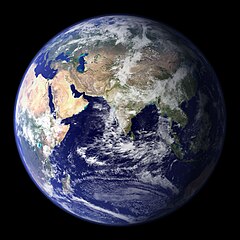We learned before about
Earth's gravity and how it pulls you to the ground.
The reason it does that is because of something called
mass.
Mass is sort of like how heavy something is, but also how big it is.
So a marshmallow as big as a house may be heavy enough to squash you,
but if you had a marshmallow as big as a bowling ball, the bowling ball is heavier.
A bowling ball is pretty heavy, but a bowling ball the size of a penny would be pretty light.
The two things that work together for mass are
size and something called
density.
Density is another big word that means something like how thick a thing is for it's size.
If something has really big size and density (like Earth) then it has really big mass.
If it is big but fluffy like a cloud, it has small mass.
If it is small but really thick density like a marble, it has small mass.
And if it is small and fluffy like a marshmallow then it has really small mass.

(from: wikipedia -
earth)

(from: wikipedia -
marshmallow)








